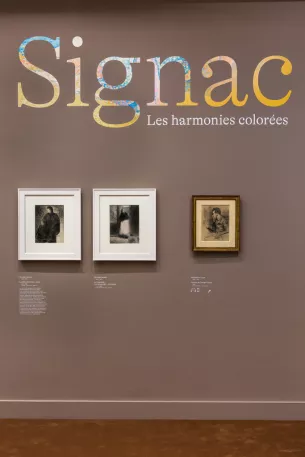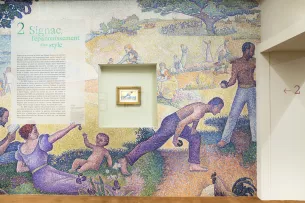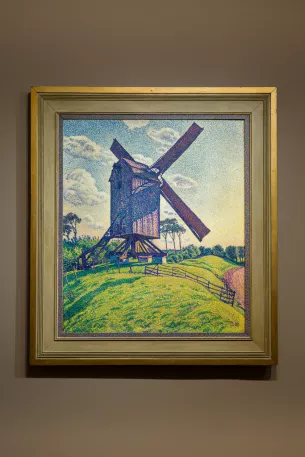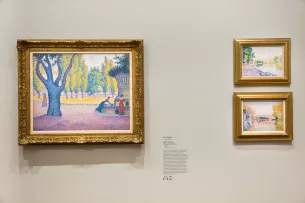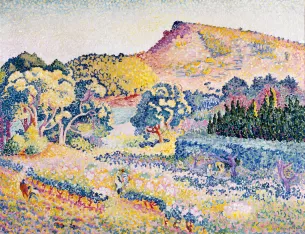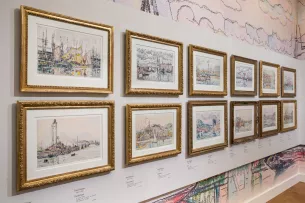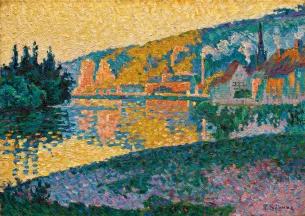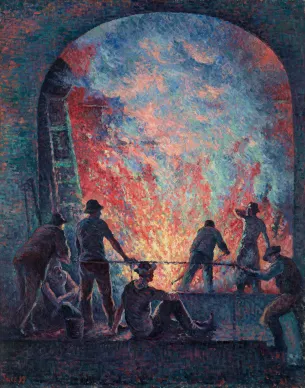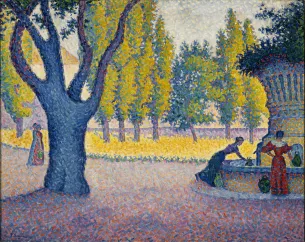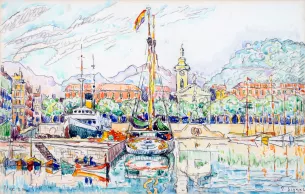Exceptional closing at 6 p.m. on October 18.
ONLINE BOOKING STRONGLY RECOMMENDED. Due to the high number of visitors to the exhibition, access cannot be guaranteed for visitors without tickets.
Exhibition
Signac
and colour harmonies
In 2021, discover the oeuvre of Paul Signac (1863–1935), the master of landscape painting and the principal theoretician of neo-Impressionism, with an exhibition of seventy works held in the finest collection of privately-owned neo-Impressionist works. Alongside twenty-five of his paintings, such as Bow of the Boat (1888), The Beacons at Saint-Briac (1890), After the Storm, Saint-Tropez (1895), Avignon. Matin (1909), and Juan-les-Pins, The Evening (1914) and twenty watercolours, the exhibition will feature more than twenty works by Georges Seurat, Camille Pissarro, Maximilien Luce, Théo Van Rysselberghe, Henri-Edmond Cross, Louis Hayet, Achille Laugé, Georges Lacombe, and Georges Lemmen.
The entire exhibition will be based on a chronological itinerary, starting with the first Impressionist pictures painted by Signac under the influence of Claude Monet, followed by the brightly coloured works created by the artist in the twentieth century, including his encounter with Georges Seurat in 1884. The exhibition, which will retrace Signac’s life and his work to liberate colour, will also explore the history of neo-Impressionism.
As an introduction, a room will be devoted to the presentation of the neo-Impressionist movement. Then, a large section will focus on Signac’s first neo-Impressionist paintings, followed by the Saint-Tropez period, where he decided to spend the summer each year from 1892 to 1913. The works painted in Paris and Brittany contrast with the brightly coloured pictures inspired by the Midi. The exhibition will illustrate the painter’s stylistic development, which gradually freed itself from Seurat’s theories to take neo-Impressionism in the direction of an increasinglycolourful form of pictorial expression. Signac strove to promote the movement and the works of his confrères will be displayed in the heart of the exhibition.
In the last three rooms of the exhibition, the museum will exhibit Signac’s twentieth-century works. Through his innovative approach, Signac paved the way for a new generation of Fauvist, Futurist, and abstract artists. At the time, he painted many watercolours and a selection of these works will underline the fact that they had an increasingly important role to play in his work.
The team
Marina Ferretti helped to prepare Paul Signac’s Catalogue Raisonné, which was published in 2000 by Françoise Cachin, and was in charge of the Archives Signac from 1985 to 2012. From 2003 to 2009, she worked at the Mairie of Le Cannet and was responsible for setting up the Musée Bonnard. Appointed scientific director of the Musée des Impressionismes at Giverny in 2009, she continued in this post until her retirement in 2019. A specialist in the work of Signac and neo-Impressionism, she has curated many exhibitions, in particular ‘Signac’ (the Grand Palais, Paris; the Vincent van Gogh Museum, Amsterdam; and the Metropolitan Museum of Art, New York, 2001); ‘Paul Signac’ (Fondation Pierre Gianadda, Martigny, Switzerland, 2003); ‘Le Neo-Impressionism. De Seurat à Paul Klee’, with Serge Lemoine (the Musée d’Orsay, Paris, 2005); ‘Neo-Impressionism, from Light to Color’ (the Abeno Harukas Art Museum, Osaka, and Tokyo Metropolitan Art Museum, 2014) and ‘Signac, les couleurs de l’eau’ (the Musée des Impressionisms, Giverny, and the Musée Fabre, Montpellier, 2013). She is also the author and editor of many catalogues and publications, notably Signac Aquarelliste (2001) and L’Impressionism (in the collection ‘Que sais-je ?’, 2005).
Pierre Curie is a Chief Heritage Curator. A specialist in seventeenth-century Italian and Spanish painting, he has also studied French nineteenth-century painting at the Musée du Petit Palais, where he began his career as a curator. Subsequently responsible for painting in the Inventaire Général, he co-wrote and compiled the Vocabulaire typologique et technique de la peinture et du dessin (published in 2009). Appointed head of the painting section in the restoration department at the Centre de Recherche et de Restauration des Musées de France in 2007, he has coordinated several major painting restoration projects in national museums (works by Leonardo da Vinci, Titian, Rembrandt, and Poussin). Pierre Curie has been a curator at the Musée Jacquemart-André since January 2016.


